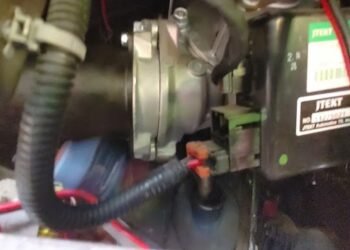You turn the key, but nothing happens. Your car won’t start when it’s hot.
This common issue frustrates many drivers, especially during summer months. A car that refuses to start when it’s hot can be puzzling. Various factors might cause this problem, from fuel system issues to electrical faults. Understanding why your car acts up in the heat can save you time and stress.
In this blog post, we’ll explore the potential reasons behind this problem. We will also offer practical tips to get your vehicle running smoothly again. Whether you’re stuck in a parking lot or your driveway, these insights can help you troubleshoot and resolve the issue.
Common Symptoms
Experiencing issues with your car not starting when it’s hot can be frustrating. Identifying common symptoms can help narrow down the problem. Two primary symptoms are engine cranks but won’t start and intermittent starting issues.
Engine Cranks But Won’t Start
One of the most common symptoms is the engine cranking but not starting. This symptom may be due to:
- Fuel system problems: A clogged fuel filter or a faulty fuel pump can restrict fuel flow.
- Ignition system issues: Bad spark plugs, ignition coils, or a malfunctioning ignition control module can prevent the engine from starting.
- Vapor lock: Heat can cause fuel to vaporize in the fuel lines, preventing the engine from getting the liquid fuel it needs.
Each of these issues can cause the engine to crank but not start, especially when the car is hot.
Intermittent Starting Issues
Intermittent starting issues are another common symptom. These problems can be tricky to diagnose as they are not consistent. Possible causes include:
- Faulty starter motor: The starter motor may work sporadically due to overheating or worn-out parts.
- Electrical problems: Loose or corroded connections, especially in the battery, can cause intermittent starting.
- Crankshaft position sensor failure: This sensor monitors the position and rotational speed of the crankshaft, and its failure can prevent the engine from starting.
These intermittent issues often become more pronounced in hot weather. Regular maintenance can help prevent some of these problems.

Credit: gogirl.co.uk
Faulty Ignition Coil
When your car won’t start in hot conditions, a faulty ignition coil might be the culprit. Ignition coils are vital for converting the battery’s voltage to the higher voltage needed to ignite the fuel. Over time, ignition coils can wear out, especially in high temperatures, leading to a car that refuses to start when hot.
Symptoms Of A Bad Ignition Coil
Recognizing the symptoms of a bad ignition coil can save you from being stranded. Here are some common signs:
- Engine Misfires: The car may shudder or jerk.
- Difficulty Starting: Especially when the engine is hot.
- Decreased Fuel Efficiency: You might notice lower MPG.
- Check Engine Light: Often illuminates for ignition issues.
- Rough Idling: The engine runs unevenly while idle.
Replacing The Ignition Coil
Replacing a faulty ignition coil is essential for a smooth-running car. Here is a step-by-step guide:
- Locate the Ignition Coil: It’s usually near the engine or along the spark plug wires.
- Disconnect Battery: Ensure safety by disconnecting the car battery.
- Remove the Old Coil: Unplug the electrical connector and remove the bolts.
- Install the New Coil: Place the new coil, secure it with bolts, and reconnect the electrical connector.
- Reconnect Battery: Reconnect the battery and start the engine to test.
| Step | Description |
|---|---|
| 1 | Locate the ignition coil near the engine. |
| 2 | Disconnect the car battery for safety. |
| 3 | Remove the old ignition coil. |
| 4 | Install the new ignition coil. |
| 5 | Reconnect the battery and test the engine. |
Vapor Lock
Vapor lock is a common issue that affects cars, especially in hot weather. It occurs when the fuel in the lines vaporizes. This creates bubbles that block the fuel flow to the engine. As a result, the car won’t start when hot. Understanding the causes and prevention can help keep your car running smoothly.
Causes Of Vapor Lock
Vapor lock happens due to heat. High temperatures cause the fuel to boil. Older cars are more prone to this issue. Their fuel systems are not designed for modern fuel blends. Poor ventilation around the fuel lines can also lead to vapor lock. Fuel lines running close to hot engine parts are at risk. Low fuel pressure is another contributing factor. This can occur from a weak fuel pump.
Preventing Vapor Lock
Keep your car well-maintained. Regularly check the fuel lines. Ensure they are properly insulated. Use a heat shield if necessary. Keep the fuel system clean. Replace old fuel filters. Use high-quality fuel that is less likely to vaporize. Avoid running your car on low fuel. This increases the chance of vapor lock. Park in shaded areas during hot weather. This helps keep the fuel cooler. If vapor lock occurs, let the engine cool down before restarting.

Credit: www.youtube.com
Fuel Pump Issues
One common reason a car won’t start when hot is fuel pump issues. The fuel pump delivers fuel from the tank to the engine. If it fails, your car may struggle to start, especially in hot conditions.
Signs Of A Failing Fuel Pump
Several signs point to a failing fuel pump. One sign is engine sputtering at high speeds. This happens when the pump can’t supply enough fuel. Another sign is the car losing power when climbing hills. The fuel pump may not maintain pressure under stress.
Poor fuel efficiency can also be a sign. A failing pump works harder, consuming more fuel. Lastly, you might hear a whining noise from the fuel tank. This noise often means the pump is wearing out.
Fixing Fuel Pump Problems
First, check the fuel pump relay. It controls the power to the pump. A bad relay can mimic pump failure. Replace it if needed. Next, test the fuel pressure. Use a fuel pressure gauge to check the levels. Compare the readings with your car’s manual.
If the pressure is low, the pump may need replacement. Always buy a quality fuel pump for your car. Cheap pumps fail sooner and can cause more issues. Finally, consider professional help. A mechanic can diagnose and fix fuel pump problems accurately.
Battery And Electrical Problems
Car not starting when hot can be frustrating. The issue often lies with the battery and electrical systems. Heat can affect these components, leading to start-up problems. In this section, we’ll focus on checking the battery and inspecting the electrical connections.
Checking The Battery
A hot engine can strain the battery. Start by checking the battery’s charge level. Use a voltmeter to measure the voltage. A fully charged battery should read around 12.6 volts. If it reads below 12 volts, the battery might be weak or failing.
Also, inspect the battery for corrosion and leaks. Corrosion around the terminals can prevent proper electrical flow. Clean any buildup with a mixture of baking soda and water. If you see leaks, the battery needs replacement.
Inspecting Electrical Connections
Next, inspect all electrical connections. Loose or dirty connections can disrupt the flow of electricity. Check the battery terminals, starter connections, and ground wires.
- Battery Terminals: Ensure they are tight and clean.
- Starter Connections: Check the wires leading to the starter for tightness.
- Ground Wires: Ensure the ground connections are secure and free of dirt.
Use a wrench to tighten any loose connections. Clean dirty connections with a wire brush or sandpaper. Good contact points are crucial for the electrical system to function properly.
| Component | Action |
|---|---|
| Battery | Check charge, clean corrosion, replace if leaking |
| Battery Terminals | Clean and tighten |
| Starter Connections | Inspect and tighten |
| Ground Wires | Clean and secure |
These steps should help in diagnosing and fixing electrical issues causing your car to not start when hot. Regular maintenance of the battery and electrical connections can prevent such issues.
Starter Motor Failure
Experiencing car trouble can be frustrating, especially when your car won’t start in hot weather. One common issue is starter motor failure. This part is essential for starting your engine. When it fails, your car stays silent. Understanding how to identify and fix starter motor issues can save you time and stress.
Identifying Starter Motor Issues
First, listen for unusual sounds. A clicking noise often signals a starter motor problem. If you hear this, the motor may struggle to engage. Another sign is a grinding noise. This happens when the starter gear doesn’t mesh well with the flywheel.
Pay attention to your dashboard lights. If they dim when you turn the key, the starter motor might be drawing too much power. Also, consider the age of your car. Older vehicles are more prone to starter motor issues.
Repairing Or Replacing The Starter Motor
If you identify starter motor issues, it’s time to act. First, check the battery and connections. A weak battery can mimic starter problems. Clean and tighten any loose connections. If the issue persists, the starter motor likely needs repair or replacement.
You can remove the starter motor yourself if you are handy with tools. This involves disconnecting the battery, removing the starter, and installing a new or rebuilt unit. If you’re not comfortable with this, take your car to a mechanic. They can quickly diagnose and fix the problem.
Regular maintenance can extend the life of your starter motor. Keep your battery in good condition and address any electrical issues promptly. Doing so can help prevent starting problems in hot weather.
Cooling System Malfunctions
Car won’t start when hot? This could point to cooling system malfunctions. The cooling system keeps the engine’s temperature in check. If it fails, the engine can overheat. This can lead to starting problems. Understand the symptoms and maintenance of the cooling system to avoid such issues.
Overheating Symptoms
Overheating can cause many problems. Steam from the engine is a clear sign. The temperature gauge may spike. You may smell something burning. These signs often show up before the car refuses to start.
Maintaining The Cooling System
Regular maintenance is key. Check coolant levels often. Low coolant can cause overheating. Inspect the radiator and hoses. Look for leaks or damage. Clean the radiator to ensure it works well.
Replace old or worn out parts. The thermostat and water pump should be in good condition. These components help regulate the engine’s temperature. Regular checks can prevent breakdowns. Keep your cooling system in top shape to avoid hot start problems.
Professional Diagnosis
Understanding why your car won’t start when hot can be tricky. A professional diagnosis might be necessary. An expert can pinpoint the problem accurately. This ensures you don’t waste time or money on unnecessary repairs.
When To Seek Help
If you experience these issues, seek professional help:
- The car starts fine when cold, but struggles when hot.
- You notice unusual smells or sounds.
- The car stalls frequently in hot conditions.
- The engine overheats regularly.
These signs indicate a deeper issue. It’s best to get a professional diagnosis sooner rather than later.
Finding A Trustworthy Mechanic
Finding a trustworthy mechanic is crucial. Follow these tips:
- Ask friends or family for recommendations.
- Check online reviews and ratings.
- Look for certifications and experience.
- Get quotes from multiple mechanics.
- Visit the shop to check cleanliness and organization.
Choosing the right mechanic can save you time and money. It also ensures your car gets the best care.

Credit: www.reddit.com
Frequently Asked Questions
Why Does My Car Not Start When Hot?
When a car is hot, components may expand. This can cause electrical issues or fuel vaporization problems.
What Are Common Reasons For A Hot Engine Not Starting?
Common reasons include vapor lock, faulty starter, weak battery, or bad ignition coil. Check these components.
How Can I Fix Vapor Lock In My Car?
To fix vapor lock, let the engine cool. Insulate fuel lines. Use a fuel additive to prevent vaporization.
Can A Weak Battery Cause My Car To Not Start When Hot?
Yes, a weak battery can struggle more when hot. Heat increases resistance, making starting difficult.
Should I Check The Starter If My Car Won’t Start When Hot?
Yes, a faulty starter may fail more often when hot. It’s crucial to inspect and replace if necessary.
Conclusion
A car that won’t start when hot can be frustrating. Regular maintenance is crucial. Check your battery and starter. Inspect fuel and ignition systems. Clean the engine area. Keep your car cool by parking in shade. Seek professional help if needed.
Addressing these issues early can save you time and money. Ensure your car runs smoothly in all conditions. Stay proactive with your car’s health. Keep it reliable and efficient. Safe driving!
















